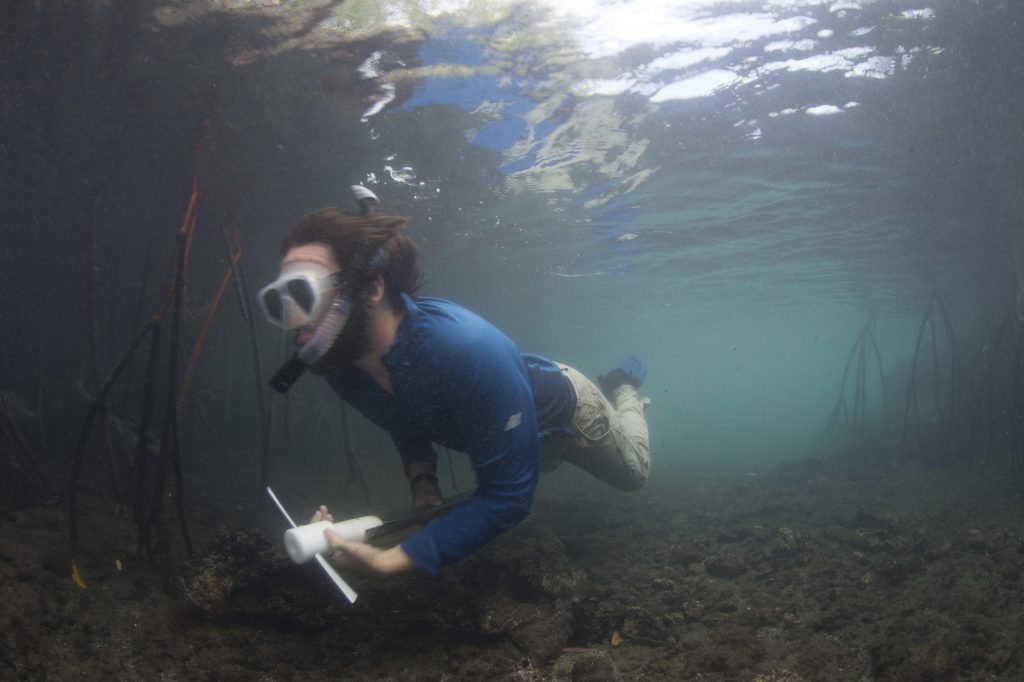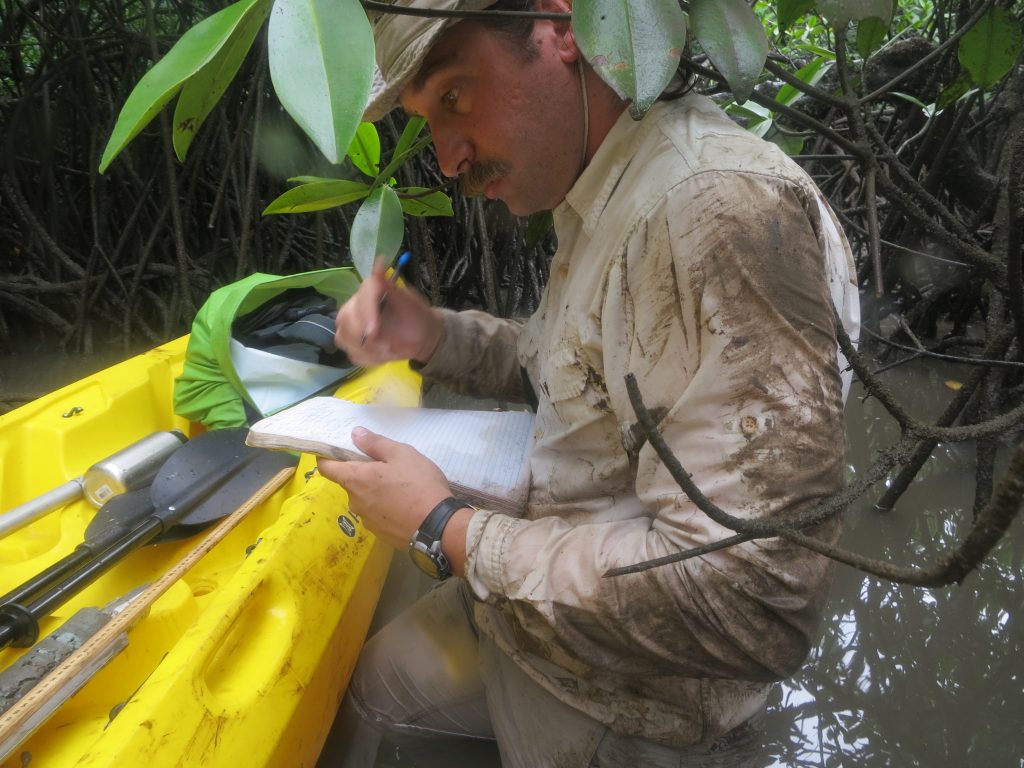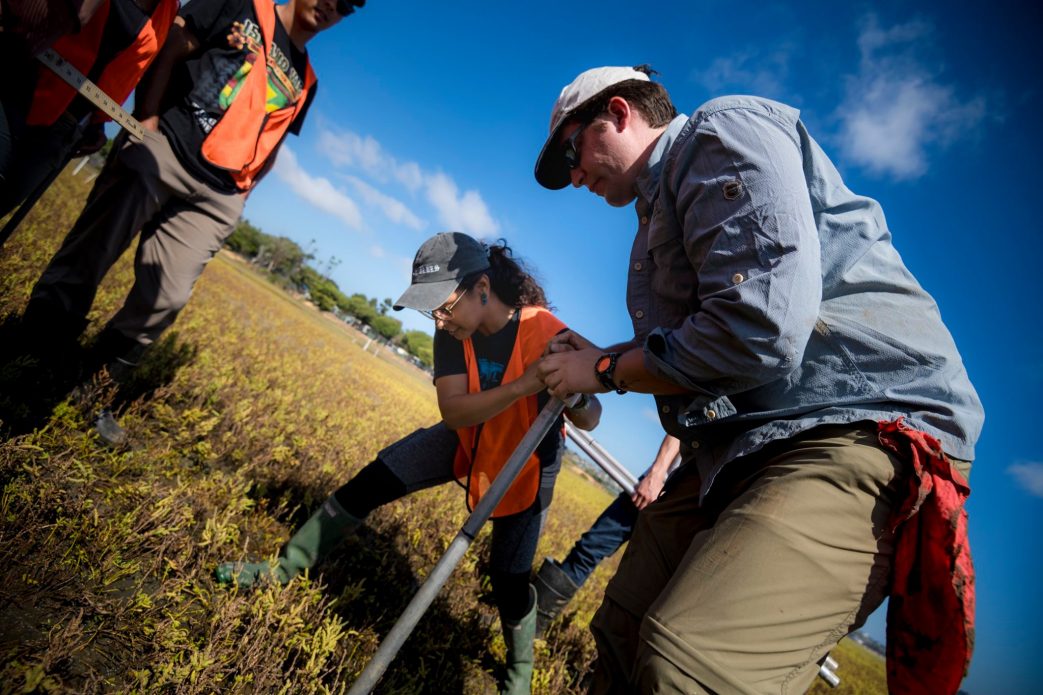This week we’re highlighting postdoctoral scholar Matthew Costa and his current work at the center. Matthew received a bachelor’s degree in ecology and evolutionary biology from Princeton University, and a PhD from Scripps Institution of Oceanography where he specialized in biological oceanography.
Q: What aspect of your research helps us better understand or adapt to climate change?
I study how coastal “blue carbon” ecosystems—including seagrass beds, salt marshes, and mangroves—act as carbon sinks. These ecosystems take carbon dioxide (CO2) from the atmosphere-ocean system and turn it into plant matter via photosynthesis. Some of this plant matter gets buried within these ecosystems, which prevents the carbon from being released back into the atmosphere and ocean. This buried plant matter forms deposits called “blue carbon,” which can be stored underground for millennia.
In my research, I work to understand what factors ensure the preservation of these blue carbon deposits. I’m working on mapping out the distribution of these sediments in coastal environments to better understand the way carbon moves in and out of these systems.
Q: What climate change-related research projects are you working on currently?
A: I’m currently studying the carbon content and burial rate of salt marshes in Mission Bay, which is here in San Diego, California. Before the accelerated development of San Diego after World War II, Mission Bay was about 50% intertidal wetland, while today only about 1% of this area remains.
The City of San Diego is currently undergoing a planning process which will determine how extensive wetland restoration will be in the northeast corner of the bay. Because salt marshes provide climate change mitigation and adaptation value on our coast, this project has direct value to the planning happening in the city. Through this work, I’m helping the Center for Climate Change Impacts and Adaptation to provide scientific tools and information for climate solutions in our local coastal communities.
Q: What does a typical workday look like for you?
A: Most days I am in the lab, processing and analyzing cores and sediment samples, or at my computer, analyzing data and working on publishing results. But getting into the field to collect samples is of course the most fun and motivating part of the process! For the work in the salt marshes, we visit the coastal wetland sites in our area and trudge out into the vegetation to collect sediment cores. This is hard, muddy work, but it’s a pleasure to be out in this special ecosystem, and the core samples that we obtain always contain new and interesting information.
For the research on sediments in La Jolla Canyon, we launch a small boat from the Scripps Pier, motor to a sampling site, and SCUBA dive to locations where we can take core samples, which are brought back to the lab for analysis. I’m always looking forward to the next sampling excursion!

Q: How did you get interested in your specific topic, or science in general?
A: I grew up in a coastal neighborhood of New York City where I had the chance to explore coastal vegetation, sandy beaches, Jamaica Bay, and the Atlantic Ocean. From early on I learned to love observing nature and digging or diving down to try to uncover the organisms and processes of the coastal landscape. I starting studying coastal wetlands in particular as part of a summer field course at the Bermuda Institute of Ocean Sciences, in which one of the class projects was a study of the biodiversity and intertidal zonation in a mangrove forest.
When I came to Scripps Institution of Oceanography for graduate school, I took my passion for studying mangroves and with the guidance of one of my advisors, Prof. Octavio Aburto-Oropeza, turned it toward a topic in the study of coastal environments that was aimed at addressing the greatest challenge facing humanity today, the mitigation of CO2 pollution. That is how I began my study of carbon burial in coastal environments, an adventure that has taken me to many amazing research sites across Latin America, through my Ph.D., to my current postdoctoral fellowship with the CCCIA!

Q: What are some surprising things that people might not know about you?
A: Some of my hobbies and interests include: swimming, sandcastles, science fiction and fantasy books, Baroque music, Latin, public transit, and Pokémon.
Q: What climate change information or resources do you want people to be aware of that they may not already know about?
A: There is a ton of information, including detailed scientific reports and more targeted information for non-scientists in the form of Summaries for Policymakers, on the IPCC website: https://www.ipcc.ch/.
The NY Times has a nice page giving easy to understand answers to basic climate change questions: https://www.nytimes.com/interactive/2017/climate/what-is-climate-change.html.
The Blue Carbon Initiative has great information on the role of coastal ecosystems in mitigating climate change: https://www.thebluecarboninitiative.org/.
You can find interesting and interactive data communications on some of my colleagues’ and my work in marine ecosystems, including mangrove blue carbon, on dataMares: http://datamares.ucsd.edu/.
Thanks for sharing, Matthew!


